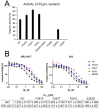Amino acid variants of SARS-CoV-2 papain-like protease have impact on drug binding
- PMID: 36409737
- PMCID: PMC9721480
- DOI: 10.1371/journal.pcbi.1010667
Amino acid variants of SARS-CoV-2 papain-like protease have impact on drug binding
Abstract
The novel severe acute respiratory syndrome coronavirus 2 (SARS-CoV-2) has caused both a health and economic crisis around the world. Its papain-like protease (PLpro) is one of the protein targets utilized in designing new drugs that would aid vaccines in the fight against the virus. Although there are already several potential candidates for a good inhibitor of this protein, the degree of variability of the protein itself is not taken into account. As an RNA virus, SARS-CoV-2 can mutate to a high degree, but PLpro variability has not been studied to date. Based on sequence data available in databases, we analyzed the mutational potential of this protein. We focused on the effect of observed mutations on inhibitors' binding mode and their efficacy as well as protein's activity. Our analysis identifies five mutations that should be monitored and included in the drug design process: P247S, E263D-Y264H and T265A-Y268C.
Copyright: © 2022 Perlinska et al. This is an open access article distributed under the terms of the Creative Commons Attribution License, which permits unrestricted use, distribution, and reproduction in any medium, provided the original author and source are credited.
Conflict of interest statement
The authors have declared that no competing interests exist.
Figures




References
-
- WHO. World Health Organization, WHO Coronavirus Disease (COVID-19) Dashboard https://covid19.who.int/table Accessed on 08 July 2022; 2022. Available from: https://covid19.who.int/table.
-
- Administration USFD. Label for NDA 207924 June 13, 2022. FDA https://wwwaccessdatafdagov/drugsatfda_docs/label/2022/207924s006lblpdf. 2022;.
-
- Administration USFD. Center for Drug Evaluation and Research. Combined cross-discipline team leader, division director, and ODE director summary review for NDA 214787 October 21, 2020. FDA https://wwwaccessdatafdagov/drugsatfda_docs/nda/2020/214787Orig1s000Sumrpdf. 2020;.
Publication types
MeSH terms
Substances
LinkOut - more resources
Full Text Sources
Medical
Research Materials
Miscellaneous

